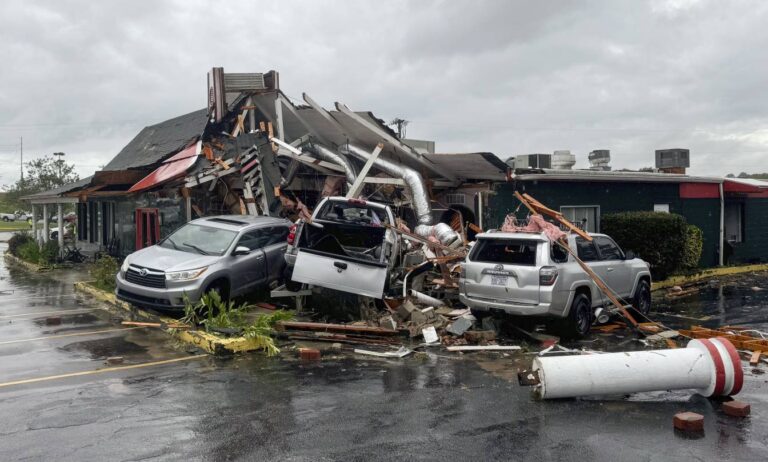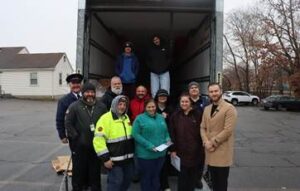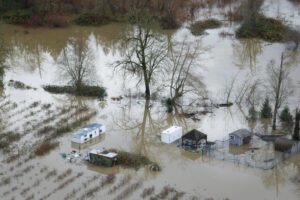ASHEVILLE, N.C. — Days of torrential rains in North Carolina culminating with tropical downpours from what was Hurricane Helene have led to officials keeping a close eye on a major dam, the closure of two main interstates in the mountains and flooding everywhere.
More than a foot of rain has fallen across much of the region in the past several days, setting the stage for an unfolding disaster as Helene moved through as a tropical storm Friday morning, Sept. 27. At least two deaths have been blamed on the storm.
The powerful, fast-moving hurricane came ashore late Thursday along the Florida Panhandle and was on top of the mountains 12 hours later. Winds gusted to 108 mph atop Mount Mitchell, the highest peak east of the Mississippi River.
All roads in western North Carolina should be considered closed because it is too dangerous to travel, the state Department of Transportation said. Interstate 40 was closed near Old Fort west of Asheville, and Interstate 26 was shut down south of Asheville near Hendersonville.
A mudslide also sent at least one lane of I-40 into the swollen Pigeon River at the North Carolina-Tennessee state line, closing the road in both directions, transportation officials said.
Crews have conducted 100 swift-water rescues as of Friday morning, Gov. Roy Cooper said, about half of them around Asheville.
“The priority now is saving lives,” Cooper said, adding that no one should be on the roads unless they were seeking higher ground.
Officials in Rutherford County were watching Lake Lure Dam because water overtopped it.
That caused some erosion on one side of the dam, state Department of Environmental Quality spokesperson Kat Russell said.
The lake, which feeds the Broad River, was created nearly 100 years ago. The dam is listed as 480 feet long and about 120 feet high.
The dam is “doing what it’s supposed to do, but the water levels are just too high,” Russell said.
Downstream communities have been made aware of the overtopping but have been told they would have several hours to alert residents about evacuations if needed, Russell said. North Carolina and South Carolina state agencies also have received emergency action plans should conditions worsen.
The lake is famous for being the setting for some scenes in the 1987 film “Dirty Dancing.”
Washed-out roads prevented first responders from making it to some calls, according to Ryan Cole, Buncombe County assistant emergency services director. That included a mudslide that involved four homes and left an undetermined number of people unaccounted for.
“This is the most significant natural disaster that anyone of us has ever seen in western North Carolina,” Cole said.
Downtown Boone saw flooding in areas where officials couldn’t recall flooding before. Appalachian State University canceled its Saturday football game with Liberty, blaming the severe impacts of the weather around the region.
At least two people were killed. A tree fell on a home in Charlotte, and bad weather led to a vehicle wreck in Catawba County, authorities said.
In Nash County, four people were critically injured Friday afternoon when a tornado in one of Helene’s outer bands damaged more than a dozen buildings in Rocky Mount, authorities said.
Forecasters were comparing it to the benchmark flood of 1916, which killed 80 people, damaged dozens of miles of railroad tracks and isolated Asheville and other mountain cities for days.
Several rivers were above or near record crests, and floodwaters were not expected to recede until at least Monday.
In Biltmore Village, just outside the famous Biltmore mansion, swiftly moving water from the overflowing Swannanoa River reached above the hoods of vehicles. It was a scene emergency officials expected in many other places, as all the rain has to flow downhill to the sea.
“It’s terrible. I don’t know if I will ever see anything like this again,” said Spencer Tate Andrews, who came down to the area to witness the flooding. “Glad I got to see it, but at the same time, it’s terrible and it’s going to affect a lot of people and businesses.”
By Erik Verduzco, The Associated Press. Associated Press writers Gary D. Robertson in Raleigh and Jeffrey Collins in Columbia, South Carolina, contributed to this report.
The Associated Press is an independent global news organization dedicated to factual reporting. Founded in 1846, AP today remains the most trusted source of fast, accurate, unbiased news in all formats and the essential provider of the technology and services vital to the news business. The Trucker Media Group is subscriber of The Associated Press has been granted the license to use this content on TheTrucker.com and The Trucker newspaper in accordance with its Content License Agreement with The Associated Press.















